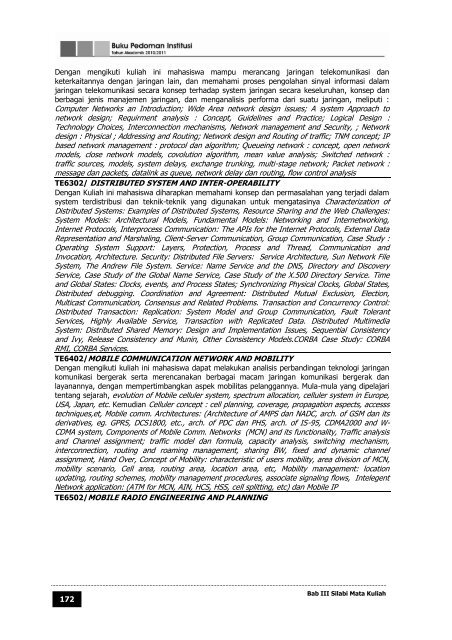buku pedoman institut teknologi telkom tahun ... - Poltekkes Medan
buku pedoman institut teknologi telkom tahun ... - Poltekkes Medan
buku pedoman institut teknologi telkom tahun ... - Poltekkes Medan
You also want an ePaper? Increase the reach of your titles
YUMPU automatically turns print PDFs into web optimized ePapers that Google loves.
Dengan mengikuti kuliah ini mahasiswa mampu merancang jaringan telekomunikasi dan<br />
keterkaitannya dengan jaringan lain, dan memahami proses pengolahan sinyal informasi dalam<br />
jaringan telekomunikasi secara konsep terhadap system jaringan secara keseluruhan, konsep dan<br />
berbagai jenis manajemen jaringan, dan menganalisis performa dari suatu jaringan, meliputi :<br />
Computer Networks an Introduction; Wide Area network design issues; A system Approach to<br />
network design; Requirment analysis : Concept, Guidelines and Practice; Logical Design :<br />
Technology Choices, Interconnection mechanisms, Network management and Security, ; Network<br />
design : Physical ; Addressing and Routing; Network design and Routing of traffic; TNM concept; IP<br />
based network management : protocol dan algorithm; Queueing network : concept, open network<br />
models, close network models, covolution algorithm, mean value analysis; Switched network :<br />
traffic sources, models, system delays, exchange trunking, multi-stage network; Packet network :<br />
message dan packets, datalink as queue, network delay dan routing, flow control analysis<br />
TE6302/ DISTRIBUTED SYSTEM AND INTER-OPERABILITY<br />
Dengan Kuliah ini mahasiswa diharapkan memahami konsep dan permasalahan yang terjadi dalam<br />
system terdistribusi dan teknik-teknik yang digunakan untuk mengatasinya Characterization of<br />
Distributed Systems: Examples of Distributed Systems, Resource Sharing and the Web Challenges:<br />
System Models: Architectural Models, Fundamental Models: Networking and Internetworking,<br />
Internet Protocols, Interprocess Communication: The APIs for the Internet Protocols, External Data<br />
Representation and Marshaling, Client-Server Communication, Group Communication, Case Study :<br />
Operating System Support: Layers, Protection, Process and Thread, Communication and<br />
Invocation, Architecture. Security: Distributed File Servers: Service Architecture, Sun Network File<br />
System, The Andrew File System. Service: Name Service and the DNS, Directory and Discovery<br />
Service, Case Study of the Global Name Service, Case Study of the X.500 Directory Service. Time<br />
and Global States: Clocks, events, and Process States; Synchronizing Physical Clocks, Global States,<br />
Distributed debugging. Coordination and Agreement: Distributed Mutual Exclusion, Election,<br />
Multicast Communication, Consensus and Related Problems. Transaction and Concurrency Control:<br />
Distributed Transaction: Replication: System Model and Group Communication, Fault Tolerant<br />
Services, Highly Available Service, Transaction with Replicated Data. Distributed Multimedia<br />
System: Distributed Shared Memory: Design and Implementation Issues, Sequential Consistency<br />
and Ivy, Release Consistency and Munin, Other Consistency Models.CORBA Case Study: CORBA<br />
RMI, CORBA Services.<br />
TE6402/MOBILE COMMUNICATION NETWORK AND MOBILITY<br />
Dengan mengikuti kuliah ini mahasiswa dapat melakukan analisis perbandingan <strong>teknologi</strong> jaringan<br />
komunikasi bergerak serta merencanakan berbagai macam jaringan komunikasi bergerak dan<br />
layanannya, dengan mempertimbangkan aspek mobilitas pelanggannya. Mula-mula yang dipelajari<br />
tentang sejarah, evolution of Mobile celluler system, spectrum allocation, celluler system in Europe,<br />
USA, Japan, etc. Kemudian Celluler concept : cell planning, coverage, propagation aspects, accesss<br />
techniques,et, Mobile comm. Architectures: (Architecture of AMPS dan NADC, arch. of GSM dan its<br />
derivatives, eg. GPRS, DCS1800, etc., arch. of PDC dan PHS, arch. of IS-95, CDMA2000 and W-<br />
CDMA system, Components of Mobile Comm. Networks (MCN) and its functionality, Traffic analysis<br />
and Channel assignment; traffic model dan formula, capacity analysis, switching mechanism,<br />
interconnection, routing and roaming management, sharing BW, fixed and dynamic channel<br />
assignment, Hand Over, Concept of Mobility: characteristic of users mobility, area division of MCN,<br />
mobility scenario, Cell area, routing area, location area, etc, Mobility management: location<br />
updating, routing schemes, mobility management procedures, associate signaling flows, Intelegent<br />
Network application: (ATM for MCN, AIN, HCS, HSS, cell splitting, etc) dan Mobile IP<br />
TE6502/MOBILE RADIO ENGINEERING AND PLANNING<br />
172<br />
Bab III Silabi Mata Kuliah


